Characterization and Degradation of Perovskite Mini-Modules
Abstract
:1. Introduction
2. Materials and Methods
2.1. Perovskite Mini-Modules
2.2. Indoor Measurement Systems
2.3. Outdoor Measurement Systems
3. Results
3.1. Perovskite Mini-Modules—Indoor Results
Systematic EL and PL Measurements of Control Samples
3.2. Outdoor Testing Results of the Mini-Modules
4. Conclusions
Author Contributions
Funding
Data Availability Statement
Conflicts of Interest
References
- NREL. Best Research-Cell Efficiency Chart. Available online: https://www.nrel.gov/pv/cell-efficiency.html (accessed on 3 July 2024).
- Li, N.; Niu, X.; Chen, Q.; Zhou, H. Towards commercialization: The operational stability of perovskite solar cells. Chem. Soc. Rev. 2020, 49, 8235–8286. [Google Scholar] [CrossRef] [PubMed]
- Baumann, F.; Raga, S.R.; Lira-Cantú, M. Monitoring the stability and degradation mechanisms of perovskite solar cells by in situ and perando characterization. APL Energy 2023, 1, 011501. [Google Scholar] [CrossRef]
- Wagner, L.; Bogachuk, D.; Qui, C.; Mathiazhagan, G.; Zouhair, S.; Hinsch, A. Characterization Methods and Technologies for Halide Perovskite Materials and Devices; Wiley-VCH: Weinheim, Baden-Wurttemberg, Germany, 2023; Chapter 2. [Google Scholar] [CrossRef]
- Manser, J.S.; Kamat, P.V. Band filling with free charge carriers in organometal halide perovskites. Nat. Photonics 2014, 8, 737–743. [Google Scholar] [CrossRef]
- Schubert, M.C.; Mundt, L.E.; Walter, D.; Fell, A.; Glunz, S.W. Spatially Resolved Performance Analysis for Perovskite Solar Cells. Adv. Energy Mater. 2020, 10, 1904001. [Google Scholar] [CrossRef]
- Hepp, J.; Machui, F.; Egelhaaf, H.; Brabec, C.J.; Vetter, A. Automatized analysis of IR-images of photovoltaic modules and its use for quality control of solar cells. Energy Sci. Eng. 2016, 4, 363–371. [Google Scholar] [CrossRef]
- Mundt, L.E.; Kwapil, W.; Yakoob, M.A.; Herterich, J.P.; Kohlstadt, M.; Wurfel, U.; Schubert, M.C.; Glunz, S.W. Quantitative Local Loss Analysis of Blade-Coated Perovskite Solar Cells. IEEE J. Photovolt. 2019, 9, 452–459. [Google Scholar] [CrossRef]
- Rakocevic, L.; Mundt, L.E.; Gehlhaar, R.; Merckx, T.; Aernouts, T.; Schubert, M.C.; Glunz, S.W.; Poortmans, J. Loss Analysis in Perovskite Photovoltaic Modules. Sol. RRL 2019, 3, 1900338. [Google Scholar] [CrossRef]
- Jošt, M.; Lipovšek, B.; Glažar, B.; Al-Ashouri, A.; Brecl, K.; Matič, G.; Magomedov, A.; Getautis, V.; Topič, M.; Albrecht, S. Perovskite Solar Cells go Outdoors: Field Testing and Temperature Effects on Energy Yield. Adv. Energy Mater. 2020, 10, 2000454. [Google Scholar] [CrossRef]
- Emery, Q.; Remec, M.; Paramasivam, G.; Janke, S.; Dagar, J.; Ulbrich, C.; Schlatmann, R.; Stannowski, B.; Unger, E.; Khenkin, M. Encapsulation and Outdoor Testing of Perovskite Solar Cells: Comparing Industrially Relevant Process with a Simplified Lab Procedure. ACS Appl. Mater. Interfaces 2022, 14, 5159–5167. [Google Scholar] [CrossRef] [PubMed]
- Velilla, E.; Jaramillo, F.; Mora-Seró, I. High-throughput analysis of the ideality factor to evaluate the outdoor performance of perovskite solar minimodules. Nat. Energy 2021, 6, 54–62. [Google Scholar] [CrossRef]
- Stoichkov, V.; Bristow, N.; Troughton, J.; De Rossi, F.; Watson, T.; Kettle, J. Outdoor performance monitoring of perovskite solar cell mini-modules: Diurnal performance, observance of reversible degradation and variation with climatic performance. Sol. Energy 2018, 170, 549–556. [Google Scholar] [CrossRef]
- Manshanden, P.; Coletti, G.; Ronchetti, M.W.; Jansen, M.J.; Rosca, V.; Späth, M.; Zardetto, V.; Verhees, W.J.H.; Dogan, I.; Fledderus, H.; et al. Prediting Outdoor Performance of Perovskite Modules with Modified Reliability Testing; EU PCSEC: Vienna, Austria, 2023. [Google Scholar] [CrossRef]
- Ali, M.U.; Mo, H.; Li, Y.; Djurišić, A.B. Outdoor stability testing of perovskite solar cells: Necessary step toward real-life applications. APL Energy 2023, 1, 020903. [Google Scholar] [CrossRef]
- Li, J.; Dagar, J.; Shargaieva, O.; Maus, O.; Remec, M.; Emery, Q.; Khenkin, M.; Ulbrich, C.; Akhundova, F.; Márquez, J.A.; et al. Ink Design Enabling Slot-Die Coated Perovskite Solar Cells with >22% Power Conversion Efficiency, Micro-Modules, and 1 Year of Outdoor Performance Evaluation. Adv. Energy Mater. 2023, 13, 2203898. [Google Scholar] [CrossRef]
- Chen, W.; Han, B.; Hu, Q.; Gu, M.; Zhu, Y.; Yang, W.; Zhou, Y.; Luo, D.; Liu, F.-Z.; Cheng, R.; et al. Interfacial stabilization for inverted perovskite solar cells with long-term stability. Sci. Bull. 2021, 66, 991–1002. [Google Scholar] [CrossRef] [PubMed]
- Ramirez, D.; Velilla, E.; Montoya, J.F.; Jaramillo, F. Mitigating scalability issues of perovskite photovoltaic technology through a p-i-n meso-superstructured solar cell architecture. Sol. Energy Mater. Sol. Cells 2019, 195, 191–197. [Google Scholar] [CrossRef]
- De Bastiani, M.; Van Kerschaver, E.; Jeangros, Q.; Rehman, A.U.; Aydin, E.; Isikgor, F.H.; Mirabelli, A.J.; Babics, M.; Liu, J.; Zhumagali, S.; et al. Toward Stable Monolithic Perovskite/Silicon Tandem Photovoltaics: A Six-Month Outdoor Performance Study in a Hot and Humid Climate. ACS Energy Lett. 2021, 6, 2944–2951. [Google Scholar] [CrossRef]
- Liu, J.; Aydin, E.; Yin, J.; De Bastiani, M.; Isikgor, F.H.; Rehman, A.U.; Yengel, E.; Ugur, E.; Harrison, G.T.; Wang, M.; et al. 28.2%-efficient, outdoor-stable perovskite/silicon tandem solar cell. Joule 2021, 5, 3169–3186. [Google Scholar] [CrossRef]
- Balaguera, E.H.; Bisquert, J. Accelerating the Assessment of Hysteresis in Perovskite Solar Cells. ACS Energy Lett. 2024, 9, 478–486. [Google Scholar] [CrossRef] [PubMed]
- Khenkin, M.V.; Katz, E.A.; Abate, A.; Bardizza, G.; Berry, J.J.; Brabec, C.; Brunetti, F.; Bulović, V.; Burlingame, Q.; Di Carlo, A.; et al. Consensus statement for stability assessment and reporting for perovskite photovoltaics based on ISOS procedures. Nat. Energy 2020, 5, 35–49. [Google Scholar] [CrossRef]
- Chowdhury, T.A.; Bin Zafar, A.; Islam, S.-U.; Shahinuzzaman, M.; Islam, M.A.; Khandaker, M.U. Stability of perovskite solar cells: Issues and prospects. RSC Adv. 2023, 13, 1787–1810. [Google Scholar] [CrossRef] [PubMed]
- Bryant, D.; Aristidou, N.; Pont, S.; Sanchez-Molina, I.; Chotchunangatchaval, T.; Wheeler, S.; Durrant, J.R.; Haque, S.A. Light and oxygen induced degradation limits the operational stability of methylammonium lead triiodide perovskite solar cells. Energy Environ. Sci. 2016, 9, 1655–1660. [Google Scholar] [CrossRef]
- Li, W.; Zhang, W.; Van Reenen, S.; Sutton, R.J.; Fan, J.; Haghighirad, A.A.; Johnston, M.B.; Wang, L.; Snaith, H.J. Enhanced UV-light stability of planar heterojunction perovskite solar cells with caesium bromide interface modification. Energy Environ. Sci. 2016, 9, 490–498. [Google Scholar] [CrossRef]
- Ding, C.; Yin, L.; Wang, J.; Larini, V.; Zhang, L.; Huang, R.; Nyman, M.; Zhao, L.; Zhao, C.; Li, W.; et al. Boosting Perovskite Solar Cells Efficiency and Stability: Interfacial Passivation of Crosslinked Fullerene Eliminates the “Burn-in” Decay. Adv. Mater. 2023, 35, 2207656. [Google Scholar] [CrossRef] [PubMed]
- Duan, L.; Zhang, Y.; He, M.; Deng, R.; Yi, H.; Wei, Q.; Zou, Y.; Uddin, A. Burn-In Degradation Mechanism Identified for Small Molecular Acceptor-Based High-Efficiency Nonfullerene Organic Solar Cells. ACS Appl. Mater. Interfaces 2020, 12, 27433–27442. [Google Scholar] [CrossRef] [PubMed]
- Habisreutinger, S.N.; Noel, N.K.; Snaith, H.J. Hysteresis Index: A Figure without Merit for Quantifying Hysteresis in Perovskite Solar Cells. ACS Energy Lett. 2018, 3, 2472–2476. [Google Scholar] [CrossRef]
- Tress, W. Metal Halide Perovskites as Mixed Electronic–Ionic Conductors: Challenges and Opportunities—From Hysteresis to Memristivity. J. Phys. Chem. Lett. 2017, 8, 3106–3114. [Google Scholar] [CrossRef] [PubMed]
- Nie, W.; Blancon, J.-C.; Neukirch, A.J.; Appavoo, K.; Tsai, H.; Chhowalla, M.; Alam, M.A.; Sfeir, M.Y.; Katan, C.; Even, J.; et al. Light-activated photocurrent degradation and self-healing in perovskite solar cells. Nat. Commun. 2016, 7, 11574. [Google Scholar] [CrossRef] [PubMed]
- Alvarez, A.O.; Arcas, R.; Aranda, C.A.; Bethencourt, L.; Mas-Marzá, E.; Saliba, M.; Fabregat-Santiago, F. Negative Capacitance and Inverted Hysteresis: Matching Features in Perovskite Solar Cells. J. Phys. Chem. Lett. 2020, 11, 8417–8423. [Google Scholar] [CrossRef] [PubMed]
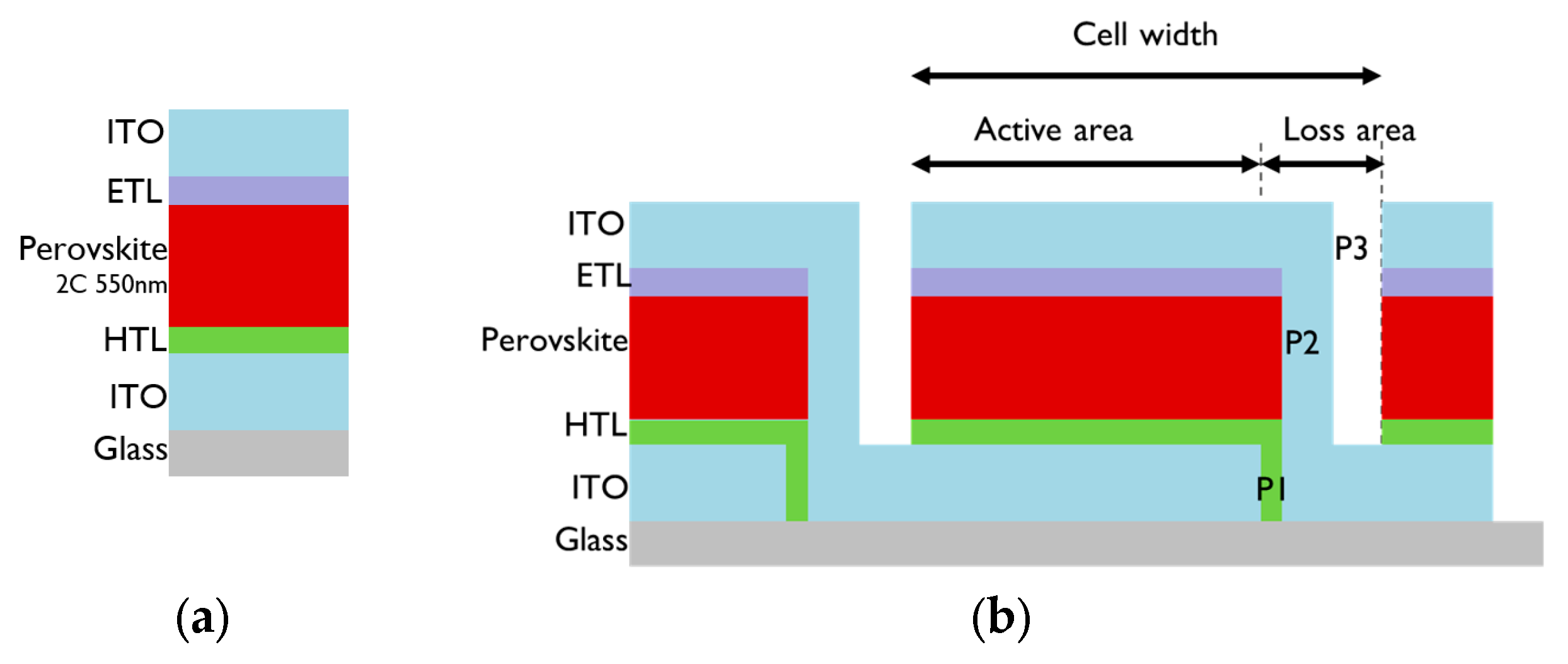


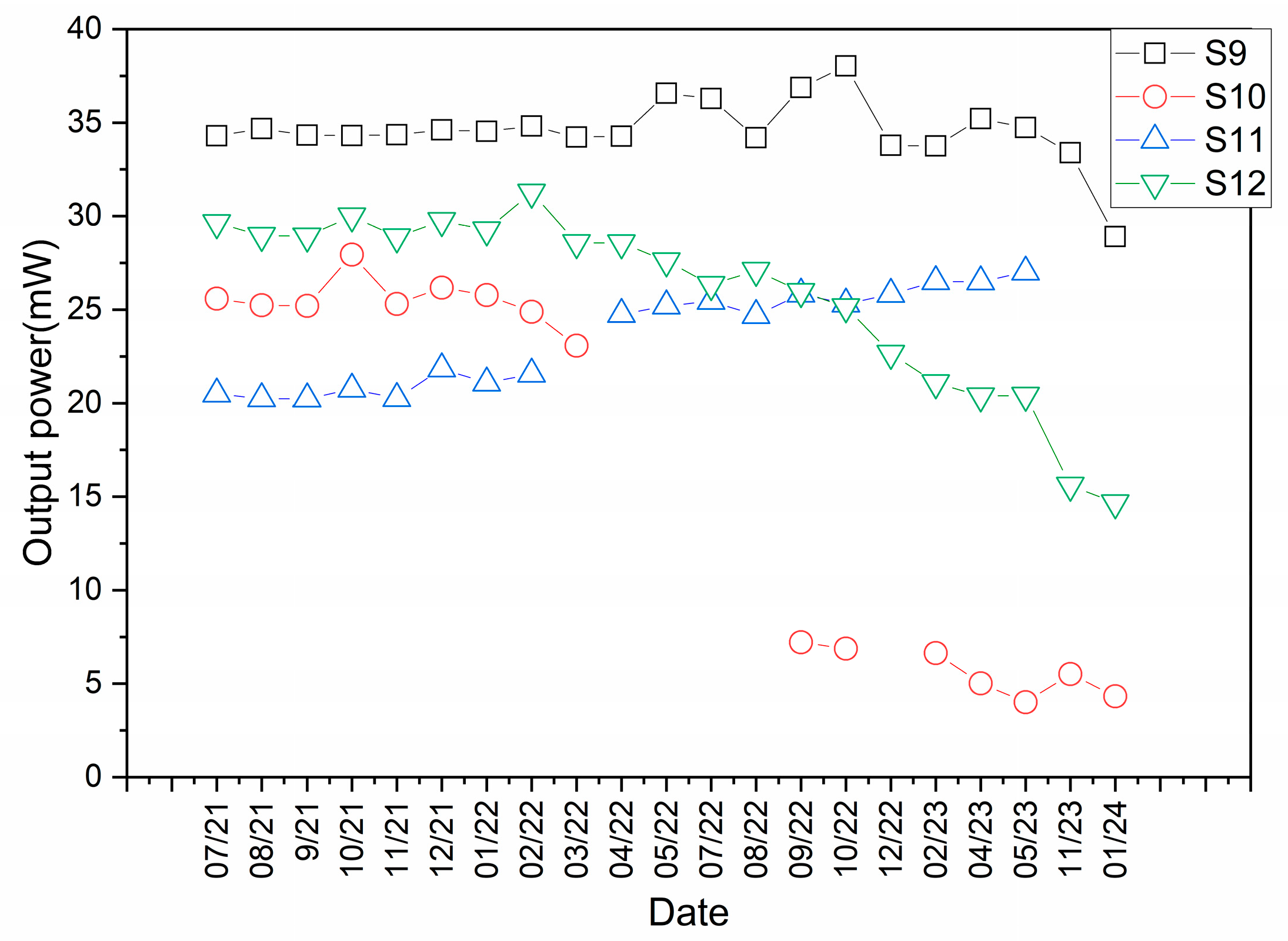

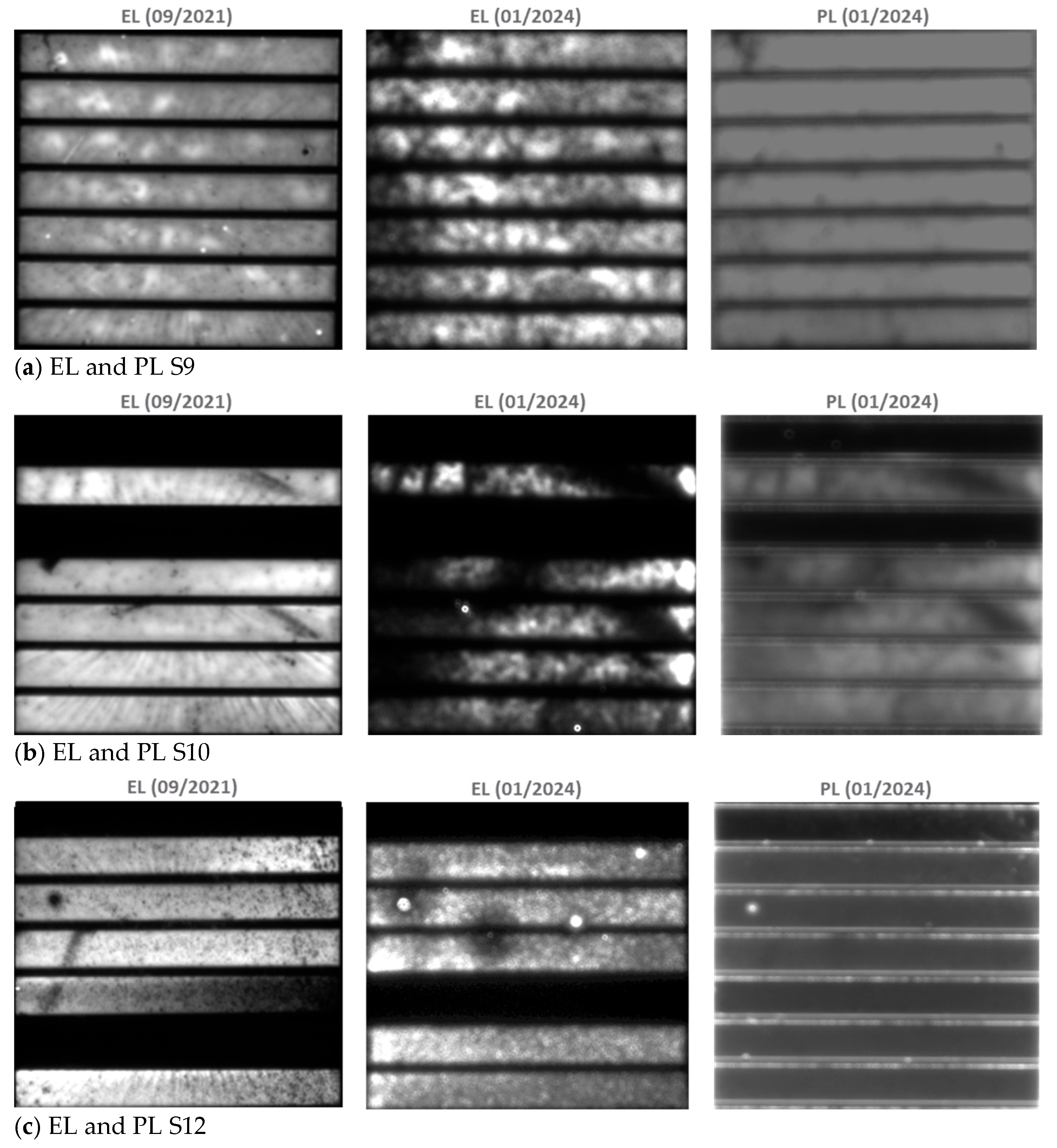
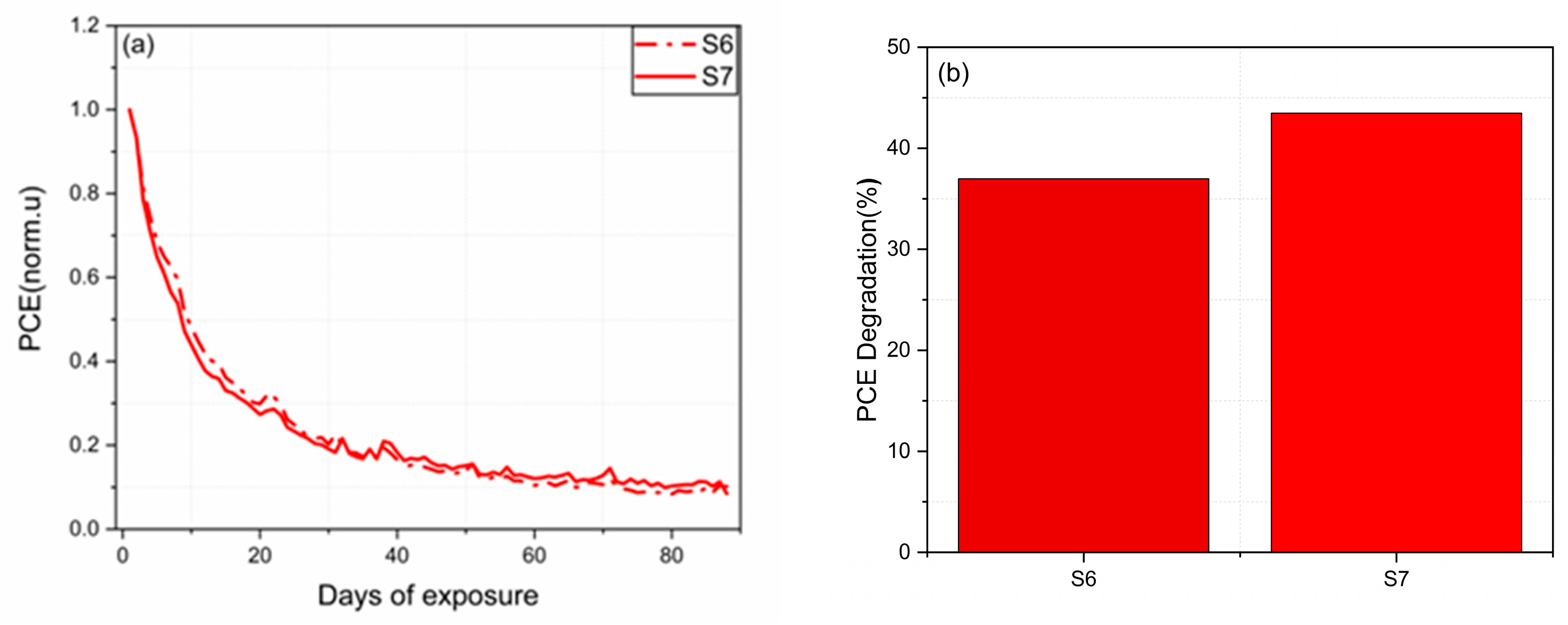
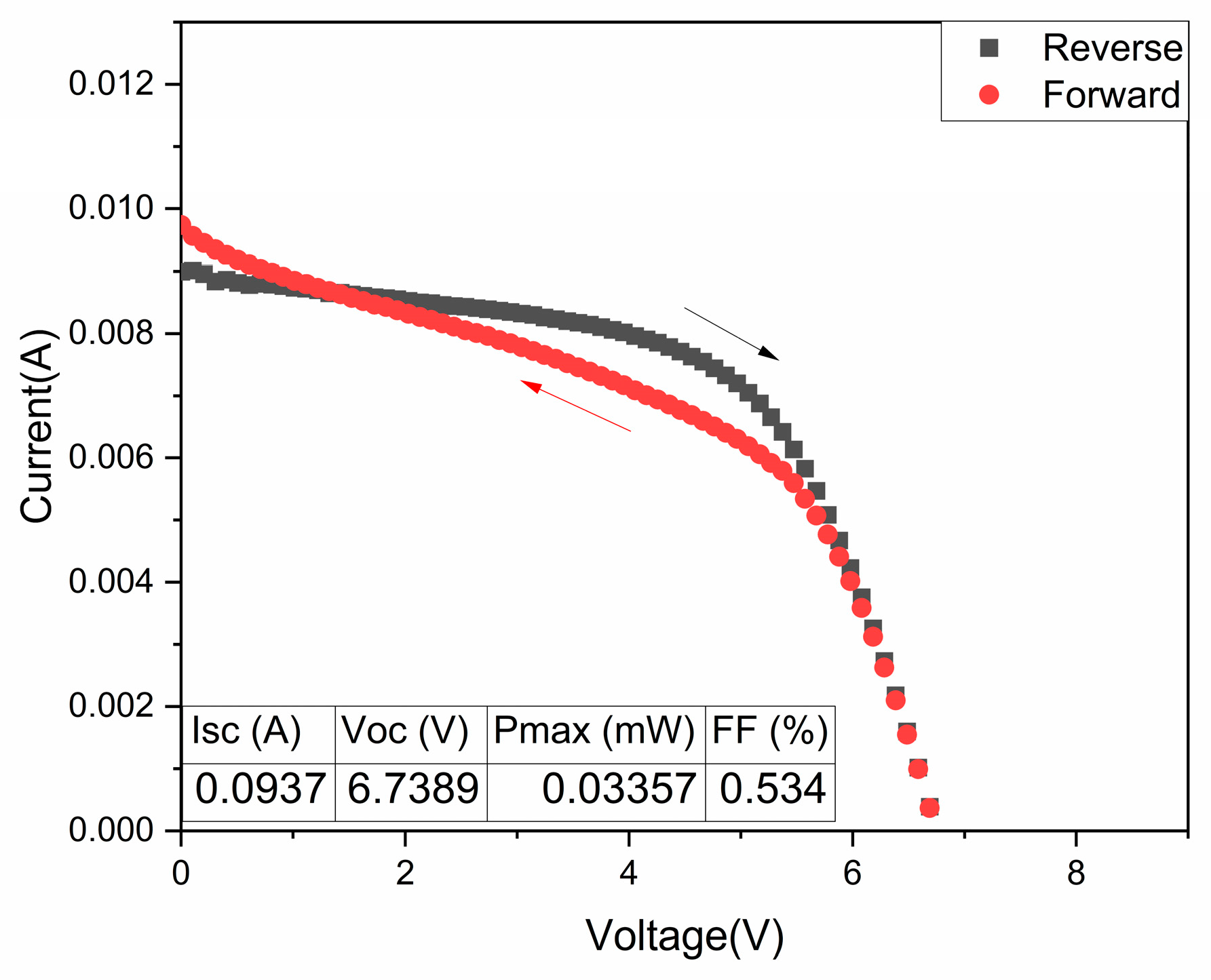




| ISC [mA] | VOC [V] | FF [%] | PMPP [mW] | Jsc [mA/cm2] | |
|---|---|---|---|---|---|
| S9 | 10.26 | 7.789 | 42.91 | 34.29 | 13.10 |
| S10 | 10.56 | 6.106 | 39.70 | 25.59 | 13.48 |
| S11 | 10.37 | 5.260 | 37.60 | 20.50 | 13.24 |
| S12 | 10.44 | 6.993 | 40.60 | 29.64 | 13.33 |
| Mini-Module | ISC [mA] | VOC [V] | FF [%] | PMPP [mW] | Jsc [mA/cm2] |
|---|---|---|---|---|---|
| S10 | 10.56 | 6.106 | 39.70 | 25.59 | 13.48 |
| S10 DLIT | 10.39 | 6.756 | 39.81 | 27.94 | 13.27 |
| Mini-Module | ISC [mA] | VOC [V] | FF [%] | PMPP [mW] | Jsc [mA/cm2] |
|---|---|---|---|---|---|
| S10 initial value | 10.56 | 6.106 | 39.70 | 25.59 | 13.48 |
| S10 DLIT October 2021 | 10.39 | 6.756 | 39.81 | 27.94 | 13.27 |
| S10 November 2021 | 10.48 | 6.748 | 38.18 | 26.99 | 13.38 |
| S10 December 2021 | 10.41 | 6.737 | 37.31 | 26.18 | 13.30 |
| S10 January 2022 | 10.43 | 6.764 | 36.95 | 25.78 | 13.17 |
| S10 February 2022 | 10.45 | 6.843 | 34.80 | 24.89 | 13.35 |
| S10 March 2022 | 10.38 | 6.397 | 34.73 | 23.07 | 13.26 |
Disclaimer/Publisher’s Note: The statements, opinions and data contained in all publications are solely those of the individual author(s) and contributor(s) and not of MDPI and/or the editor(s). MDPI and/or the editor(s) disclaim responsibility for any injury to people or property resulting from any ideas, methods, instructions or products referred to in the content. |
© 2024 by the authors. Licensee MDPI, Basel, Switzerland. This article is an open access article distributed under the terms and conditions of the Creative Commons Attribution (CC BY) license (https://creativecommons.org/licenses/by/4.0/).
Share and Cite
Ebner, R.; Mittal, A.; Ujvari, G.; Hadjipanayi, M.; Paraskeva, V.; Georghiou, G.E.; Hadipour, A.; Aguirre, A.; Aernouts, T. Characterization and Degradation of Perovskite Mini-Modules. Inorganics 2024, 12, 219. https://doi.org/10.3390/inorganics12080219
Ebner R, Mittal A, Ujvari G, Hadjipanayi M, Paraskeva V, Georghiou GE, Hadipour A, Aguirre A, Aernouts T. Characterization and Degradation of Perovskite Mini-Modules. Inorganics. 2024; 12(8):219. https://doi.org/10.3390/inorganics12080219
Chicago/Turabian StyleEbner, R., A. Mittal, G. Ujvari, M. Hadjipanayi, V. Paraskeva, G. E. Georghiou, A. Hadipour, A. Aguirre, and T. Aernouts. 2024. "Characterization and Degradation of Perovskite Mini-Modules" Inorganics 12, no. 8: 219. https://doi.org/10.3390/inorganics12080219
APA StyleEbner, R., Mittal, A., Ujvari, G., Hadjipanayi, M., Paraskeva, V., Georghiou, G. E., Hadipour, A., Aguirre, A., & Aernouts, T. (2024). Characterization and Degradation of Perovskite Mini-Modules. Inorganics, 12(8), 219. https://doi.org/10.3390/inorganics12080219







